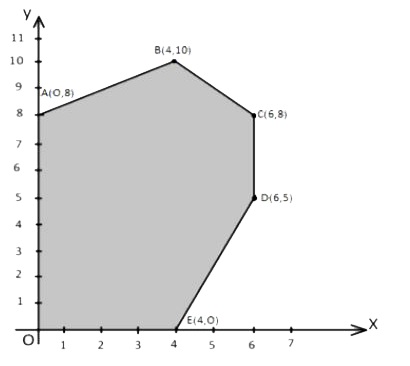Corner points of the feasible region determined by the system of linear constraints are (0,3), (1,1), and (3,0). Let Z=px+qy. Where p,q<0 Condition on p and q, so that the minimum of Z occurs at (3,0) and (1,1) is
p=2q
p=q2
p=3q
p=q
The correct Answer is:B
To solve the problem, we need to determine the conditions on p and q such that the minimum of Z=px+qy occurs at the corner points (3,0) and (1,1) of the feasible region defined by the given linear constraints.
1. Identify the corner points: The corner points of the feasible region are given as (0,3), (1,1), and (3,0).
2. Evaluate Z at the corner points:
- For point (1,1):
Z1=p(1)+q(1)=p+q
- For point (3,0):
Z2=p(3)+q(0)=3p
3. Set the conditions for minimum: We want Z1 and Z2 to be equal for both points to be minimum:
Z1=Z2
Therefore, we have:
p+q=3p
4. Rearranging the equation: From the equation p+q=3p, we can rearrange it to find q:
q=3p−p
q=2p
5. Expressing the relationship: We now have the relationship between p and q:
q=2p
6. Condition on p and q: Since it is given that both p and q are less than 0 (i.e., p<0 and q<0), we can conclude:
- If p<0, then q=2p<0 as well.
Final Conditions:
The condition on p and q such that the minimum of Z occurs at (3,0) and (1,1) is:
q=2pwithp<0
- For point (1,1):
Z1=p(1)+q(1)=p+q
- For point (3,0):
Z2=p(3)+q(0)=3p
Z1=Z2
Therefore, we have:
p+q=3p
q=3p−p
q=2p
q=2p
- If p<0, then q=2p<0 as well.
The condition on p and q such that the minimum of Z occurs at (3,0) and (1,1) is:
q=2pwithp<0
Topper's Solved these Questions
Similar Questions
The corner points of the feasible region determined by the system of linear constraints are as shown below:

Let Z=px+qy where p,q>0 be the objective function. Find the condition on p and q so that the maximum value of Z occurs atB(4,10)andC(6,8)Also mention the number of optimal solutions in this case.
View SolutionThe corner points of the feasible region determined by the following system of linear inequalities:
2x+y≥10,x+3y≤15,x,y≥0 are (0,0),(5,0),(3,4) and (0,5). Let Z=px+qy, where p,q≥0. Condition on p and q so that the maximum of Z occurs at both (3,4) and (0,5) is:
(a) p=q (b) p=2q (c) p=eq (d) q=3p
View Solution
Knowledge Check
Corner points of the feasible region determined by the system of linear constraints are (0,3), (1,1), and (3,0). Let Z=px+qy. Where p,q<0 Condition on p and q, so that the minimum of Z occurs at (3,0) and (1,1) is
Ap=2qBp=q2Cp=3qDp=qThe corner points of the feasible region determined by the system of linear constraints are (0,10) , (5,5) (25,20),(0,30) Let z = px + qy , where p,q>0 Condition on p and q so that te maximum of z occurs at both the points (25,20 ) and (0,30) is ………
A5p = 2qB2p=5qCp = 2qDq = 3pThe corner points of the feasible region determined by the system of linear constraints are (0, 10), (5, 5) (15, 15), (0, 20). Let Z = px + qy , where p,q>0. Then, the condition on p and q so that the maximum of Z occurs at both the points (15, 15) and (0, 20), is
Ap=qBp=2qCq=2pDq=3p
For an objective function Z=ax+by, where a,b>0, the corner points of the feasible region determined by a set of constraints (linear inequalities) are (0, 20), (10, 10), (30, 30) and (0, 40). The condition on a and b such that the maximum Z occurs at both the points (30, 30) and (0, 40) is:
View SolutionThe corner points of a feasible region determined by a system of linear inequations are (0,0),(4,0),(5,2),(2,2) and (0, 1). If the objective function is Z = x + y, then maximum of Z occurs at:
View SolutionThe corneer points of a feasible region, determined by a system of linear inequations, are (0,0),(1,0),(4,3),(2,1)and(0,1). If the objective function is Z=2x−3y, then the minimum value of Z is :
View SolutionThe corner points of the feasible region determined by the system of linear constraints are (0, 0), (0, 40). (20, 40), (60, 20). (60, 0). "The objective function is Z=4x+3y.
Compare the quantity in Column A and Column B.
Column AColumn BMaximum of Z325
View SolutionFor an objective function Z = ax + by, where a,b>0, the corner points of the feasible region determined by a set of constraints (linear inequalities) are (0, 20). (10, 10), (30, 30) and (0, 40). The condition on a and b such that the maximum z occurs at both the points (30, 30) and (0, 40) is:
View Solution
